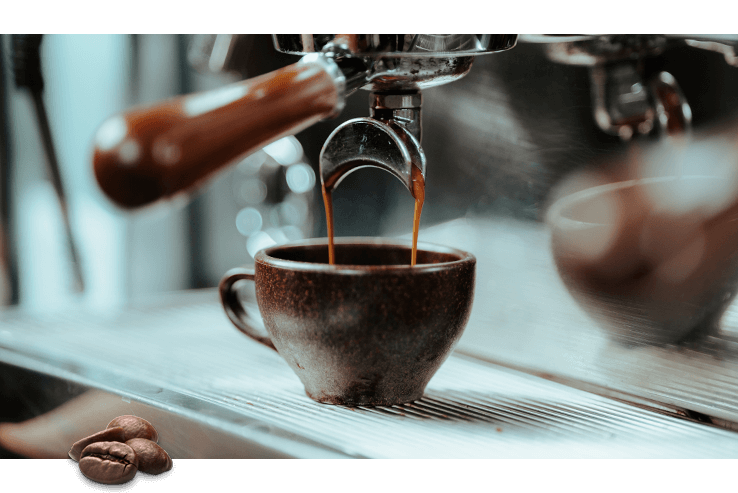What Makes SOE Single Origin Espresso Different from Combination Beans
What Makes SOE Single Origin Espresso Different from Combination Beans
Blog Article
Coffee Beans 101: Whatever You Need to Understand About Espresso and Blended Coffee Beans
When it comes to coffee, comprehending the subtleties of coffee and combined beans can change your everyday cup. You'll discover the unique features of Arabica and Robusta beans, and just how each impacts flavor and high levels of caffeine material. From the growing process to toasting methods, every step contributes in your coffee experience. What makes the perfect brew? Let's discover the necessary components that add to an extraordinary cup of coffee.
Understanding Coffee Beans: Selections and kinds
When diving right into the globe of coffee, understanding the types and ranges of coffee beans is essential for every enthusiast. Arabica beans are known for their smooth, intricate flavors and reduced caffeine material, making them a favored amongst coffee connoisseurs.
Within these species, you'll find different local ranges, each bringing distinct characteristics. Ethiopian Yirgacheffe supplies intense flower notes, while Colombian beans give a healthy taste profile. As you discover, remember to focus on handling methods like cleaned or all-natural, as they can considerably affect the last preference. By acquainting on your own with these beans and their flavors, you'll elevate your coffee experience and make more educated choices in your developing trip.
The Expanding Process: From Seed to Bean
When you discover the trip of coffee, everything begins with seed choice techniques that establish the foundation for top quality. From there, growing and harvesting play important roles in ensuring the beans thrive. Ultimately, handling techniques transform those gathered cherries into the coffee beans you like.
Seed Selection Techniques
Selecting the best seeds is necessary for generating premium coffee beans, as it lays the foundation for the whole expanding procedure. Pay focus to the seed's age and storage space problems, as fresh seeds often tend to sprout much better. Think about the illness resistance of different selections, as this can greatly influence your return.
Growing and Harvesting
As you nurture your coffee seeds right into growing plants, understanding the farming and harvesting procedure is crucial for achieving the very best taste and high quality. Beginning by growing your seeds in well-draining dirt, ideally in a shaded location to secure them from direct sunshine. As your plants grow, maintain regular wetness, and be mindful of their demand for nutrients. Prune consistently to promote airflow and healthy and balanced development.
Hand-picking is often the ideal method to ensure just the ripest cherries are chosen. Timing is vital; gathering too early or as well late can impact the taste account of your beans.

Handling Methods Described
As soon as you've harvested your coffee cherries, the following essential step is refining them to change those vivid fruits into the beans you'll brew. There are two main techniques: the completely dry procedure and the damp procedure. In the completely dry process, you spread the cherries out in the sun to completely dry, permitting the fruit to ferment and impart unique flavors to the beans. On the other hand, the wet process includes getting rid of the fruit instantly and fermenting the beans in water, resulting in a cleaner taste. After processing, the beans are hulled, sorted, and usually dried again. Each approach influences the taste account, so trying out both can aid you uncover your preferred mixture. Comprehending these techniques is crucial to appreciating your coffee experience.
Roasting Strategies: Exactly How Flavor Is Created
When it involves roasting coffee beans, understanding roast degrees is essential to exposing their distinct tastes. Each toasting method impacts the aroma and boosts the flavor development procedure, giving you a richer coffee experience. Allow's explore exactly how these aspects come together to elevate your daily mixture.
Roast Degrees Described
Roast degrees play a vital function fit the taste profile of your coffee. You'll delight in intense acidity and fruity notes when you pick a light roast. As you move to a tool roast, you'll discover an equilibrium of sweetness and intricacy, typically highlighting delicious chocolate or caramel flavors. Dark roasts, on the various other hand, deliver vibrant, smoky attributes with less acidity, making them abundant and robust. Each degree arises from various roasting times and temperature levels, impacting the beans' chemical composition. By understanding these degrees, you can better pick a coffee that matches your taste choices. Try out various roasts to find which one resonates with you, enhancing your overall coffee experience and pleasure.
Effect On Fragrance
The roast degree not just affects the taste of your coffee however additionally greatly influences its scent. When you choose a light roast, you'll usually observe brilliant, flower notes that can make your coffee smell vibrant and fresh. As the beans darken, the scent shifts; a medium roast draws out extra balanced, caramelized fragrances, while a dark roast tends to include bold, great smoky undertones. Each roasting strategy launches different volatile substances, forming exactly how your coffee scents. Additionally, the freshness of the beans plays a crucial duty; fresh baked coffee releases a lot more fragrant oils, improving that enticing scent. So, focus on the roast degree-- it's key to exposing the complete fragrant experience of your mixture.
Flavor Advancement Refine
As you discover the flavor growth process, you'll find that roasting techniques play an important role in shaping the taste account of your coffee. The toasting temperature level and time directly influence the acidity, sweet taste, and anger of the beans. Light roasts preserve even more of the bean's initial tastes, highlighting fruity and flower notes. Medium roasts balance level of acidity and body, supplying a well-shaped flavor. Dark roasts, on the other hand, draw out strong, great smoky qualities while diminishing the bean's inherent qualities. During roasting, chemical reactions, like the Maillard reaction and caramelization, transform the beans and boost their intricacy. Try out different roasting levels can aid you locate your excellent mixture, so don't hesitate to taste and find the abundant range of flavors!
Coffee vs. Blended Coffee: Key Differences
Espresso and mixed coffee each offer one-of-a-kind experiences that accommodate different preferences and choices. Coffee is a concentrated coffee brewed by compeling warm water through finely-ground coffee beans, causing a rich, bold taste and a velvety layer of crema ahead. It's commonly delighted in as a shot or used as a base for beverages like coffees and lattes.
On the various other hand, combined coffee combines various beans from various regions, creating a much more balanced flavor profile. You'll frequently find blends that highlight sweetness, level of acidity, or body, making them flexible for various brewing techniques. While coffee concentrates on intensity, combined coffee may provide a wider variety of flavors that can change with each sip.
Ultimately, your selection in between espresso and mixed coffee boils down to your individual preference. Whether you long for a leisurely mug or a quick shock, both alternatives have something tasty to use.

Developing Approaches: Unlocking the Perfect Cup
When it involves brewing coffee, locating the right method can change your experience and boost your cup. Each developing technique has its special appeal and can significantly influence your coffee's flavor and scent. For instance, using a French press allows you to enjoy a abundant and robust brew, while a pour-over method offers a clean, intense mug with distinctive tastes.
If you like espresso, buying a top quality device can help you master the art of Bonuses drawing shots. For ease, a single-serve shuck system offers rate without sacrificing preference.
Don't forget concerning chilly brew, which provides a smooth, less acidic coffee ideal for warm days. Experiment with various methods to uncover what resonates with your taste buds.
Tasting Notes: Determining Taste Profiles
Exactly how can you really value your coffee if you do not understand what tastes to look for? Sampling notes are your overview to understanding the intricate globe of coffee. Some coffees could leave a chocolatey or caramel aftertaste, while others might have a brilliant, tidy coating.
Think about the body of the coffee, too; is it ventilated and light or thick and syrupy? Do not forget level of acidity; a bright level of acidity can add liveliness, while a low level of acidity might give a smoother experience. By determining these taste accounts, you'll strengthen your connection with each mug, making coffee sampling a wonderful journey of exploration.

Tips for Choose and Storage Coffee Beans
Choosing and saving coffee beans appropriately can significantly improve your developing experience. Start by choosing top notch beans that match your preference. Seek quality; beans roasted within the last two weeks are perfect. Check the roast day on the product packaging, and get from trustworthy roasters or neighborhood stores.
Once you have your beans, save them in an airtight container to avoid exposure to light, air, and dampness. A dark, amazing location functions best, so avoid maintaining them in the refrigerator or fridge freezer, as this can present wetness. Just grind the quantity you need to preserve freshness; whole beans keep flavor longer than pre-ground coffee.
Lastly, attempt to utilize your beans within 2 to four weeks after opening up for peak preference. Complying with these ideas will guarantee your coffee stays savory and enjoyable, raising your daily mixture to new heights.
Regularly Asked Concerns
How Much Time Do Coffee Beans Keep Fresh After Toasting?
Coffee beans stay fresh for about 2 weeks after toasting - SOE. You should save them in an impermeable container, away from light and moisture. Afterwards, their flavor and fragrance start to reduce significantly

Can I Mix Different Coffee Bean Varieties?
Definitely, you can mix various coffee bean varieties! Explore blends can boost flavors and develop a special taste account. Simply make certain to stabilize the strengths and characteristics of each range for the very best outcomes.
What Is the Suitable Work Size for Coffee?
For espresso, you'll desire a fine grind size, concerning the structure of table salt. This enables optimal removal, leading to an abundant, tasty shot. Experiment a little bit to find wikipedia reference what fits your preference best!
Exactly How Does Elevation Affect Coffee Bean Flavor?
Elevation affects coffee bean flavor by affecting the growth rate and chemical make-up. Greater elevations cause slower growth, which enhances acidity and intricacy, offering your coffee a vibrant and distinct preference you will not fail to remember.
Exist Decaffeinated Versions of Espresso Beans?
Yes, there are decaffeinated variations of coffee beans. You can take pleasure in an abundant espresso taste without the high levels of caffeine kick. Simply search for "decaf" blends at your neighborhood coffee shop or specialty shop.
Coffee Beans 101: Everything You Required to Know Concerning Coffee and this content Blended Coffee Beans.
When diving into the world of coffee, recognizing the types and varieties of coffee beans is crucial for every enthusiast.When it comes to roasting coffee beans, understanding roast levels is crucial to exposing their one-of-a-kind tastes. Coffee is a focused coffee brewed by forcing hot water through finely-ground coffee beans, resulting in a rich, strong taste and a velvety layer of crema on top.On the various other hand, combined coffee combines various beans from different regions, producing an extra well balanced flavor account.
Report this page